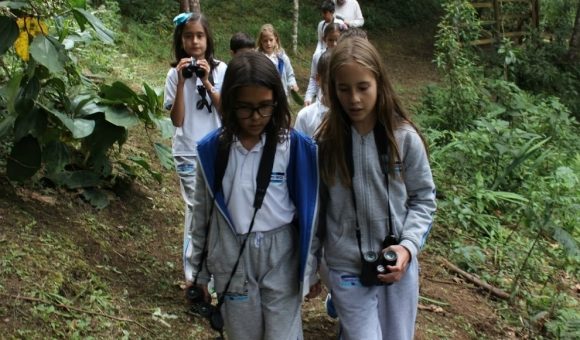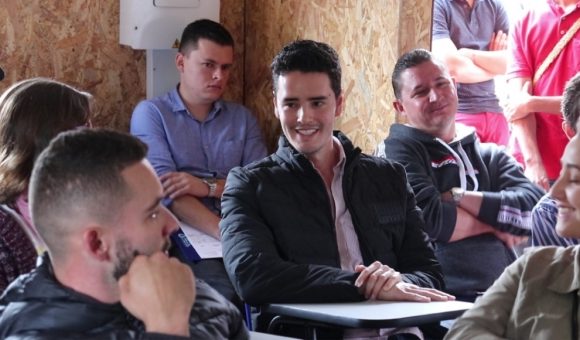Colegio Theodoro Hertzl School Reports 2 Antisemitic Incidents

Colegio Theodoro Hertzl – a nominally Jewish primary/secondary school in the Medellin suburb of Envigado, well-known for its outstanding scholarship, multiculturalism, peacefulness and tolerance – announced February 27 a pair of antisemitic incidents, but fortunately these didn’t involve violence.
According a statement from Hertzl school’s rector, Nidia Londoño Echeverry, the two incidents happened February 26 during a special internationalization event featuring several invited guests.
Here is what Londoño said:
“During the program, we had the opportunity to offer not only to our students but to our sister schools the opportunity to have contact with 22 universities from 10 different countries in Europe, the U.S. and Central America,” Londoño explained.
However, during this event, “two isolated and contained situations occurred. Out of respect for the institution and the people, we choose to maintain anonymity [of the two people involved].
“The first situation has to do with a student who was wearing a keffiyeh — characteristic Arab attire — with some drawings of weapons.
“It is extremely important to note that his behavior at all times was respectful and calm. We understand that this outfit could be interpreted by some students as a provocation. However, here we have a great pedagogical challenge of coexistence and acceptance of difference as long as it is within the framework of respect for others.
“The second situation was with another student from another institution, who apparently made a comment between the hallways to one of our students, claiming his sympathy for Hitler.
“This situation was contained by the educators present — from the same pedagogical, reflective and critical framework — and was taken as a learning opportunity, explaining that hate speech has no place in this school.
“It is essential to highlight that we are guided by the principles of prudence and respect within the framework of coexistence. We value the importance of fostering an environment of coexistence and promoting constructive dialogue between all members of our educational community,” Londoño concluded.
For those readers of Medellin Herald who may be unfamiliar with the Theodoro Hertzl school, we reproduce our original report from our August 24, 2015 edition:
Colegio Theodoro Hertzl: Bilingual Education, Cultural Diversity, Great Place
By Roberto Peckham
Medellin Herald
August 24, 2015
Among Medellin’s various bilingual primary and secondary schools (kindergarten through 12th grade) is the outstanding Colegio Theodoro Hertzl (CTH), a nominally Jewish institution that emphasizes English, math and computer skills – and welcomes students and teachers of other faiths and nations.
In an interview with Medellin Herald, CTH director Nidia Londoño explained that while a majority of the classes at the school are conducted in English, it’s necessary for students to be able to speak, read and write in Spanish as well.
So, for the growing number of Colombian (and non-Colombian) parents who are returning to Medellin after many years of working and living in the U.S., Europe, Australia or elsewhere – and whose children predominantly speak a language other than Spanish – it’s recommended that these children first go through intensive Spanish-language training at a local educational institute before applying for admission to CTH, Londoño said.
At CTH, early-grade studies in subjects including mathematics are taught in English. But the advanced courses in mathematics for the higher-grade levels at CTH are in Spanish, she said.
Of the 400 students at CTH, a maximum of 25 are in any single classroom at one time, she said. Demand for pre-school (kindergarten) enrollment especially has exceeded the available space, so CTH has had to turn-away many such applicants recently.
To give an idea of the level of English competency at CTH, a video shows students – most speaking in English – explaining the history, activities and curriculum at the school.
Students at the school come from several countries and some speak different languages, although all of them also speak Spanish, she said. Teachers come from Colombia, Venezuela, Argentina, Spain, Israel and the United States, she added.
CTH employs the “Horaa Mutemet” (Hebrew for “education for diversity”) teaching methodology developed in Israel. This method originally was designed to address the diverse educational, language and cultural needs of Jews returning to Israel following the centuries-long diaspora that scattered people all over the world.
But this method also is especially suited to the multicultural situation at CTH, as it takes into account the cultural and language differences of its various students and teachers, Londoño explained.
“Horaa Mutemet” also can be seen as a novel way of addressing educational issues arising from the Colombian diaspora of recent decades, as millions of Colombians of various faiths have migrated overseas to work, study and start families in many countries (including North America and Europe). Having a novel teaching method for returnees to Colombia, which recognizes these multicultural issues, can be especially useful.
In order to graduate from CTH, students must pass the standardized Test of English as a Foreign Language (TOEFL) exam, she said. Preparatory studies for TOEFL start in the eighth grade.
Teachers at CTH are certified in a European version of Teaching English to Speakers of Foreign-Languages (TEFL), she added.
While CTH’s curriculum includes what many would consider as “normal” classes at primary/secondary schools — such as math, science and social studies — it also has classes in Hebrew as well as “religion.”
Parents get the final word on whether they want their children to study Judaism, Catholicism or Evangelical Christianity at CTH — although CTH also welcomes children of other faiths, as well as agnostics or atheists, she said.
A rabbi conducts classes for students whose parents want their children to study Judaism at CTH, while Catholic and Christian scholars conduct separate classes for children whose parents want their children to study those faiths at CTH.
As for the teaching of Hebrew at CTH, this only seems logical for a nominally Jewish school.
However, non-Jewish students likewise benefit, as this experience teaches them how to read right-to-left rather than left-to-right, Londoño said. This novel exercise stimulates certain brain cells that are also used for mathematics and for learning new languages, she added.
CTH celebrates both the Jewish holidays as well as Colombian national holidays. But it makes-up for any lost school days by starting its school year earlier than most other Colombian schools, she explained.
“Awareness” Method of Discipline
As for parent interaction with teachers and school officials, parents are “very much involved,” Londoño said.
For example: If a student is having behavioral problems, CTH teachers and staff employ the awareness (“concientizar”) method, a middle ground between severe discipline used at some schools, or laxness employed at other schools, she said.
This method involves asking the student their reason for misbehaving, explaining to them why it’s not appropriate, and getting the child to recognize and admit the misbehavior. Sometimes this involves bringing parents to the school so that they can learn what is happening, discuss appropriate discipline and find a solution, she added.
Rather than just removing a misbehaving student from the classroom and sitting them in some isolated space where they do nothing, the student instead is instructed to continue the same classroom tasks by themselves, apart from their fellow students, she added.















